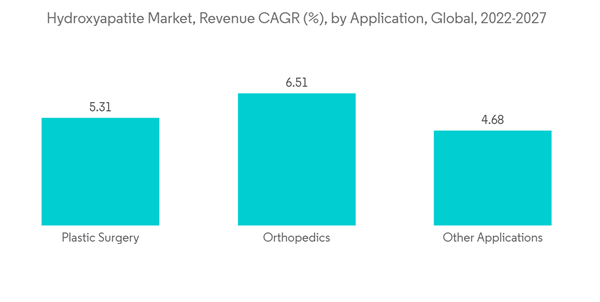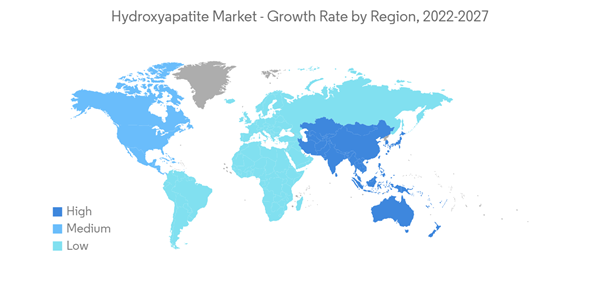The Hydroxyapatite Market size is estimated at USD 2.56 billion in 2024, and is expected to reach USD 3.5 billion by 2029, growing at a CAGR of 6.52% during the forecast period (2024-2029).
Though COVID-19 negatively impacted the market in 2020, it has reached pre-pandemic levels.
The major factors driving the growth of the hydroxyapatite market include the rising interest in prosthetic applications and increasing demand from the orthopedic segment.
This product will be delivered within 2 business days.
Though COVID-19 negatively impacted the market in 2020, it has reached pre-pandemic levels.
The major factors driving the growth of the hydroxyapatite market include the rising interest in prosthetic applications and increasing demand from the orthopedic segment.
Key Highlights
- On the other side, the high expenditure on implants is anticipated to impact the growth of the market studied.
- Nevertheless, the development of 3D printing technological advancement is expected to provide opportunities to the market studied.
- North America is expected to be the largest market for hydroxyapatite and its products during the forecast period.
Hydroxyapatite Market Trends
Orthopedic Segment to Dominate the Hydroxyapatite Market
- Hydroxyapatite (HAp) is a fundamental calcium phosphate existing as the primary material of bones, teeth, and minerals, generally with high bi-affinity. Its composition promotes osseointegration between bone and orthopedic implants, allowing for the ultimate structural and functional connection. Due to its versatility, hydroxyapatite is becoming increasingly popular as an implant coating.
- Due to the similarity between nano-hydroxyapatite and mineralized bone, HAp powders have a high affinity to hard tissues. They bond chemically with the host tissue bringing about improved biological performance. These items produce bone graft substitutes, such as porous granules and block scaffolds for bone recovery.
- With the development of nanotechnology, a significant effect on materials science has been noted. Nano-hydroxyapatite (nano-HAp) is rising as a biomaterial in orthopedic applications due to its similarity in size, crystallography, and chemical composition with human hard tissue. To a great extent, bones are made of this type of mineral.
- According to the WHO (World Health Organization), by 2030, one out of every six people will be 60 years old or older. The number of people aged 60 and more is expected to rise from 1 billion in 2020 to 1.4 billion by 2050. By 2050, the global population of adults aged 60 and up will have doubled (2.1 billion). Between 2020 and 2050, the number of people aged 80 and more is predicted to triple, reaching 426 million.
- Although the movement in population distribution toward older ages, known as population aging, began in high-income nations (for instance, in Japan, 30% of the population is already over 60 years old), it is currently low- and middle-income countries that are seeing the most change. Two-thirds of the world's population over 60 will reside in low- and middle-income countries by 2050.
- With the growing aged population and health issues in several countries worldwide, the demand for orthopedics is expected to increase during the forecast period, thus, increasing the demand for hydroxyapatite.
- All the abovementioned factors are expected to drive the demand for hydroxyapatite during the forecast period.
North America to Dominate the Market Studied
- The North American region holds a prominent share of the hydroxyapatite market globally. It is expected to dominate the market during the forecast period due to high investment and better healthcare infrastructure.
- In 2021, US healthcare spending grew by 4.2%, reaching USD 4.3 trillion after registering a growth of 9.7% in 2020. As a share of the nation's Gross Domestic Product, health spending accounted for 18.8%.
- Furthermore, according to World Bank data, the population aged 65 and above in the US stood at around 16.6% of the total population, which requires more medical attention for tooth decay and gum problems as well as a rising risk of arthritis among aged people.
- Government data showed that 75% of Canadians visit a dental clinic annually, and 86% do so at least once every two years. Thus, 84% of Canadians report their oral health as good or excellent.
- However, 34% of dentate Canadians aged 6-79 years have some treatment that needs to be identified. One out of three Canadians has a need, and only one out of six says they cannot address this need for financial reasons.
- Mexico is among the world's most popular medical tourism destinations. The overall cost of living is low relative to the United States. That means hospitals and clinics can charge much less for medical procedures. Americans who lack health insurance, thus, make the short trip across the border to Mexico for treatment.
- Thus, the rising demand from various segments is expected to drive the market studied in the region during the forecast period.
Hydroxyapatite Industry Overview
The market for hydroxyapatite is partially fragmented. Some of the players in the market include Zimmer Biomet, HOYA Technosurgical Corporation (HOYA Corporation), CGbio, Bio-Rad Laboratories Inc., and Taihei Chemical Industrial Co. Ltd.Additional Benefits:
- The market estimate (ME) sheet in Excel format
- 3 months of analyst support
This product will be delivered within 2 business days.
Table of Contents
1 INTRODUCTION1.1 Study Assumptions
1.2 Scope of the Study
2 RESEARCH METHODOLOGY
3 EXECUTIVE SUMMARY
4 MARKET DYNAMICS
4.1 Drivers
4.1.1 Rising Interest in Prosthetic Applications
4.1.2 Increasing Demand from the Orthopedic Segment
4.2 Restraints
4.2.1 High Expenditure of Implants
4.2.2 Other Restraints
4.3 Industry Value Chain Analysis
4.4 Porter's Five Forces Analysis
4.4.1 Threat of New Entrants
4.4.2 Bargaining Power of Buyers
4.4.3 Bargaining Power of Suppliers
4.4.4 Threat of Substitute Products
4.4.5 Degree of Competition
5 MARKET SEGMENTATION (Market Size by Value)
5.1 By Type
5.1.1 Nano-sized
5.1.2 Micro-sized
5.1.3 Greater than Micrometers
5.2 By Application
5.2.1 Dental Care
5.2.2 Plastic Surgery
5.2.3 Orthopedic
5.2.4 Other Applications
5.3 By Geography
5.3.1 Asia-Pacific
5.3.1.1 China
5.3.1.2 India
5.3.1.3 Japan
5.3.1.4 South Korea
5.3.1.5 Rest of Asia-Pacific
5.3.2 North America
5.3.2.1 United States
5.3.2.2 Canada
5.3.2.3 Mexico
5.3.3 Europe
5.3.3.1 Germany
5.3.3.2 United Kingdom
5.3.3.3 France
5.3.3.4 Italy
5.3.3.5 Rest of Europe
5.3.4 South America
5.3.4.1 Brazil
5.3.4.2 Argentina
5.3.4.3 Rest of South America
5.3.5 Middle East and Africa
5.3.5.1 Saudi Arabia
5.3.5.2 South Africa
5.3.5.3 Rest of Middle East and Africa
6 COMPETITIVE LANDSCAPE
6.1 Mergers and Acquisitions, Joint Ventures, Collaborations, and Agreements
6.2 Market Ranking Analysis
6.3 Strategies Adopted by Leading Players
6.4 Company Profiles
6.4.1 APS Materials Inc.
6.4.2 Berkeley Advanced Biomaterials (GNI Group Ltd)
6.4.3 Bio-Rad Laboratories Inc.
6.4.4 CGbio
6.4.5 FLUIDINOVA
6.4.6 Granulab Sdn. Bhd. (KPower Berhad)
6.4.7 HOYA Technosurgical Corporation (HOYA Corporation)
6.4.8 SANGI CO. LTD
6.4.9 SigmaGraft Biomaterials
6.4.10 Taihei Chemical Industrial Co. Ltd
6.4.11 Zimmer Biomet
7 MARKET OPPORTUNITIES AND FUTURE TRENDS
7.1 Development of 3D Printing Technologically Advancement
Companies Mentioned (Partial List)
A selection of companies mentioned in this report includes, but is not limited to:
- APS Materials Inc.
- Berkeley Advanced Biomaterials (GNI Group Ltd)
- Bio-Rad Laboratories Inc.
- CGbio
- FLUIDINOVA
- Granulab Sdn. Bhd. (KPower Berhad)
- HOYA Technosurgical Corporation (HOYA Corporation)
- SANGI CO. LTD
- SigmaGraft Biomaterials
- Taihei Chemical Industrial Co. Ltd
- Zimmer Biomet
Methodology

LOADING...










